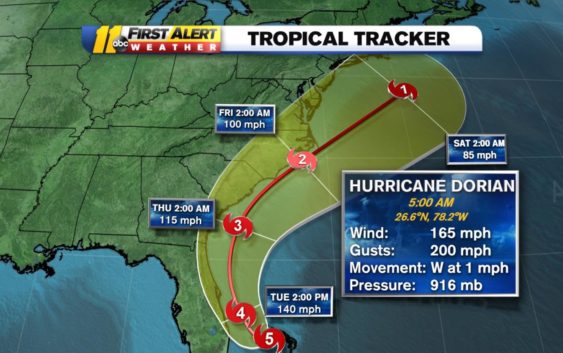- List of hurricane names 2024
- Homeowners insurance doesn't cover floods: How to protect your home in North Carolina
- Before and after: See Dubai flooding from space
- No evidence of a tornado in Rock Hill, investigation determines
- Marking 15 years since 19,000 acre wildfire destroyed dozens of homes in Horry County
Hurricane Dorian continues to batter Bahamas as powerful Category 5 storm before turning north

According to a 5 a.m. update from the National Hurricane Center in Miami, the Category 5 storm’s top sustained winds have decreased to 165 mph.
Dorian slammed into Elbow Cay in the Abaco Islands at 12:40 p.m., and then made a second landfall near Marsh Harbour on Great Abaco Island at 2 p.m., after authorities made last-minute pleas for those in low-lying areas to evacuate.
The hurricane is expected to continue battering Grand Bahama through Monday, before moving close to Florida’s coast Monday night through Wednesday evening.
The storm remains a Category 5 and Dorian is “expected to remain a powerful hurricane” during the next few days, with possible fluctuations in intensity.
5am Monday Update on #Dorian A LONG way to go on this storm, but you should be preparing for heavy rains, gusty winds, and power outages later this week. ATM, Thursday will be the ‘busy’ day in the weather dept. #ncwx pic.twitter.com/Cw5oovuW5h
— Don Schwenneker (@BigweatherABC11) September 2, 2019
WATCH: Bahamas resident shows, describes conditions as Dorian pounds island nation
“Catastrophic conditions” were reported in The Abaco Islands, with a storm surge of 18-23 feet, and Dorian was expected to cross Grand Bahama later in the day “with all its fury,” the center said.
Mandatory evacuation orders in Florida for low-lying and flood-prone areas and mobile homes are taking effect starting either Sunday or Monday from Palm Beach County north to at least the Daytona Beach area, and some counties to the north issued voluntary evacuation notices.
Millions from Florida to the Carolinas are keeping a wary eye on Dorian amid indications it would veer sharply northeastward after passing the Bahamas and track up the U.S. Southeast seaboard. But authorities warned even if its core did not make U.S. landfall and stayed offshore, the potent Category 4 storm would likely hammer U.S. coastal areas with powerful winds and heavy surf.
Gov. Roy Cooper has issued a State of Emergency in North Carolina as the state braces for the potential impacts of Hurricane Dorian.
In South Carolina, the governor issued a mandatory evacuation of the entire coast beginning Monday.
The cities of Brunswick, Georgia; Charleston, South Carolina; and Wilmington, North Carolina, could all see more than six inches of rain, according to the latest forecast.
Georgia Gov. Brian Kemp has also ordered a mandatory evacuation of the state’s Atlantic coast starting at midday Monday.
Kemp tweeted late Sunday that his executive order covers all those located east of the Interstate 95 corridor on Georgia’s Atlantic seaboard. It begins at noon EDT Monday as powerful Hurricane Dorian creeps ever closer to the U.S. Southeast.
TIMING AND PATH
As of now, we can expect the breeze to pick up out of the northeast Wednesday. Some of the outer rain bands of Hurricane Dorian may already be moving into the southern and eastern parts of North Carolina.
It will likely be breezy to windy across central North Carolina on Wednesday night into Thursday, with more showers and a thunderstorm likely. The steadiest and heaviest rain will be to the east and southeast of the Triangle.
The main thing to point out during this time is that the impacts will be greatest as far as heavy rain and stronger winds go, the farther east and southeast you are from Raleigh. We are still not ruling out a landfall somewhere along the North Carolina coast.
Dorian will begin to increase in forward speed to the northeast Thursday and Friday. While the impacts and track and can still vary between now and then, it is highly likely that at least coastal North Carolina will have a period of heavy rain, strong gusty winds and coastal flooding/beach erosion Wednesday night into Thursday.
PREPARE FOR THE STORM
While it is too early to know the impact Dorian will have, it is never to early to prepare with the essential supplies.
What to know about generators before a power outage
What happens to your home in hurricane-force winds?
Foods to stock up on before a storm hits
Copyright © 2019 ABC11-WTVD-TV/DT. All Rights Reserved – The Associated Press contributed to this report.